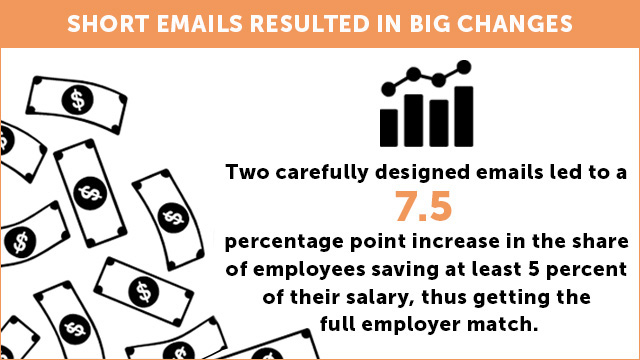To improve working conditions and increase opportunities for American workers, the U.S. Department of Labor’s (DOL) agencies and programs must effectively engage with the people and organizations they serve.
 The designers of DOL programs—which address issues such as employment, training, unemployment insurance, occupational health and safety, protection of workers’ rights, and enforcement of labor laws—usually assume that people make decisions after fully considering their options and then act on those decisions. However, behavioral science shows that this assumption can often be wrong. People procrastinate and forget to do important tasks. Too many choices and small hassles can overwhelm them.
The designers of DOL programs—which address issues such as employment, training, unemployment insurance, occupational health and safety, protection of workers’ rights, and enforcement of labor laws—usually assume that people make decisions after fully considering their options and then act on those decisions. However, behavioral science shows that this assumption can often be wrong. People procrastinate and forget to do important tasks. Too many choices and small hassles can overwhelm them.
 The designers of DOL programs—which address issues such as employment, training, unemployment insurance, occupational health and safety, protection of workers’ rights, and enforcement of labor laws—usually assume that people make decisions after fully considering their options and then act on those decisions. However, behavioral science shows that this assumption can often be wrong. People procrastinate and forget to do important tasks. Too many choices and small hassles can overwhelm them.
The designers of DOL programs—which address issues such as employment, training, unemployment insurance, occupational health and safety, protection of workers’ rights, and enforcement of labor laws—usually assume that people make decisions after fully considering their options and then act on those decisions. However, behavioral science shows that this assumption can often be wrong. People procrastinate and forget to do important tasks. Too many choices and small hassles can overwhelm them.
DOL worked with Mathematica and ideas42 to test whether applying behavioral science principles to diverse labor programs might help these programs better meet their goals. Studies suggest that relatively modest changes to program materials, forms, or processes can greatly improve participant outcomes and program performance.
The project sought to:
- Identify important problems within DOL programs for which behavioral science might provide solutions
- Diagnose the potential behavioral factors contributing to these problems
- Design program modifications and rigorous evaluations to assess their impacts
- Rapidly test the behavioral solutions
- Share results and discuss implications
- Develop and share lessons learned to help DOL, and others, in the application of behavioral insights to social programs
Conducting Trials
We conducted broad outreach activities within DOL, both to help build awareness about behavioral insights and to identify opportunities for possible behavioral trials. Based on the results of this outreach, we investigated in-depth opportunities within several federal agencies and state and local jurisdictions. We pursued three trial opportunities that allowed for rapid testing and iteration and addressed important objectives for DOL:
- Increasing retirement savings among federal employees: We partnered with the Employee Benefits Security Administration and the DOL Human Resources Division to test whether targeted emails to DOL employees could encourage full participation in the federal Thrift Savings Plan. The emails led to a 7.5 percentage point increase in the share of employees who save at least 5 percent of their salary. See infographic/video, brief, and technical report for more information.
- Improving employer responsiveness to citations: We worked with the Occupational Safety and Health Administration (OSHA) to test whether changes to its citation process could increase employer responsiveness and reduce referrals to the OSHA National Office for costly enforcement and debt collection. The revised citation process led to a 4.4 percentage point reduction in the number of employers referred to debt collection for failing to resolve their case. See infographic/video, brief, and technical report for more information.
- Increasing take-up of a reemployment program: We partnered with the W.E. Upjohn Institute and Michigan Works! to test the effectiveness of emails encouraging people to join and complete the state’s Reemployment and Eligibility Assessment program. The emails led to a 15 percentage point increase in scheduling rates for the first REA session among UI claimants and a 14 percentage point increase in REA completion rates. See infographic/video, brief, and technical report for more information.
Informing the Field
Resources that we developed to assist policymakers and practitioners in applying behavioral insights to their work include a communications checklist, a handout on quick steps to improve programs, a practitioner’s playbook, a project implementation brief, and a project podcast.
The insights gained from this work are contributing to the growing body of evidence on the effectiveness of behavioral strategies. Behavioral solutions found to improve program outcomes and performance can inform the broad adoption of such principles within DOL and many other related programs nationwide.
 The designers of DOL programs—which address issues such as employment, training, unemployment insurance, occupational health and safety, protection of workers’ rights, and enforcement of labor laws—usually assume that people make decisions after fully considering their options and then act on those decisions. However, behavioral science shows that this assumption can often be wrong. People procrastinate and forget to do important tasks. Too many choices and small hassles can overwhelm them.
The designers of DOL programs—which address issues such as employment, training, unemployment insurance, occupational health and safety, protection of workers’ rights, and enforcement of labor laws—usually assume that people make decisions after fully considering their options and then act on those decisions. However, behavioral science shows that this assumption can often be wrong. People procrastinate and forget to do important tasks. Too many choices and small hassles can overwhelm them.


